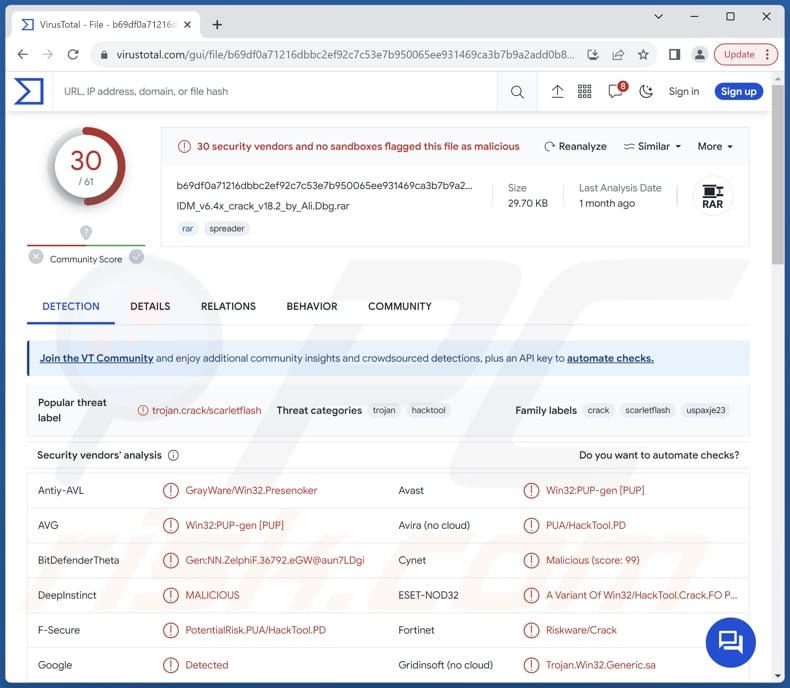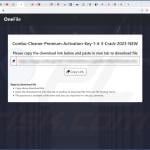How to remove malware detected as HackTool:Win32/Crack
TrojanAlso Known As: HackTool:Win32/Crack virus
Get free scan and check if your device is infected.
Remove it nowTo use full-featured product, you have to purchase a license for Combo Cleaner. Seven days free trial available. Combo Cleaner is owned and operated by RCS LT, the parent company of PCRisk.com.
What kind of malware is HackTool:Win32/Crack?
"HackTool:Win32/Crack" is a generic detection name used by a multitude of security engines and vendors for software "cracks".
"Cracks" are illegal tools utilized for "cracking" program protection; this includes bypassing the product's security measures, implementing a stolen activation key or faking one, breaking password protection by brute-force techniques, and similar.
"Cracks" are used to "pirate" (steal) various products that are offered for sale, ranging from video games to image editing software. Aside from being illegal, "cracking" tools are often employed in malware proliferation. Hence, by using "cracks" – users risk exposing their devices to malicious software.

HackTool:Win32/Crack malware overview
As mentioned in the introduction, "HackTool:Win32/Crack" is a common detection name for software "cracks". These illegal tools are oftentimes bundled with malware. "Cracks" may also serve as a disguise for malicious programs (i.e., infectious files that merely claim to operate as "cracking" tools but have no such functionality).
Content under the "HackTool:Win32/Crack" detection name (and others of its kind) can contain any type of malware. "Cracks" could be used to hide trojans.
"Trojan" in itself is a broad term encompassing malicious programs with various capabilities, including (but not limited to): backdoors that prep systems for further infection, loaders that download/install additional malware, injectors that inject malicious code into software/processes, stealers that extract and exfiltrate data, grabbers that download files, spyware that records content (e.g., desktops, audio/video via microphones and cameras, etc.), keyloggers that record keystrokes, clippers that replace clipboard content, and so on.
Ransomware is another prevalent type of malware. It is designed to encrypt files and/or lock the device's screen to demand ransoms for the decryption/ access recovery. "Cracking" tools could also proliferate cryptominers – malware that abuses system resources (potentially to the point of failure) to generate cryptocurrency.
To summarize, the presence of high-risk malware on a device can result in multiple system infections, decreased system performance or failure, data loss, hardware damage, severe privacy issues, financial losses, and identity theft.
If you suspect that your device is already infected – we strongly recommend running a full system scan with an anti-virus and removing all detected threats.
| Name | HackTool:Win32/Crack virus |
| Threat Type | Trojan, password-stealing virus, banking malware, spyware. |
| Detection Names | Avast (Win32:Malware-gen), Combo Cleaner (Gen:Variant.Application.Ulise.123186), ESET-NOD32 (A Variant Of Win32/HackTool.Crack.FO P), Malwarebytes (Generic.Malware.AI.DDS), Microsoft (HackTool:Win32/crack), Full List Of Detections (VirusTotal) |
| Symptoms | Trojans are designed to stealthily infiltrate the victim's computer and remain silent, and thus no particular symptoms are clearly visible on an infected machine. |
| Distribution methods | Freeware and free file-hosting websites, Torrenting, malicious online advertisements, social engineering. |
| Damage | Stolen passwords and banking information, identity theft, the victim's computer added to a botnet. |
| Malware Removal (Windows) |
To eliminate possible malware infections, scan your computer with legitimate antivirus software. Our security researchers recommend using Combo Cleaner. Download Combo CleanerTo use full-featured product, you have to purchase a license for Combo Cleaner. 7 days free trial available. Combo Cleaner is owned and operated by RCS LT, the parent company of PCRisk.com. |
Malware in general
There are various types of malware with a variety of functionalities. It must be mentioned that the abilities are not limited by the malware's type. For example, data-stealing software could have loader, keylogger, grabber, clipper, or other kinds of features.
However, regardless of how malware operates – its presence on a system endangers device integrity and user safety. Therefore, it is paramount to eliminate all threats immediately upon detection.
How did HackTool:Win32/Crack infiltrate my computer?
Since software "cracks" are illegal, they are promoted on various untrustworthy channels, e.g., freeware and free file-hosting websites, Peer-to-Peer sharing networks, and other third-party sources.
"Cracking" tools can be "legitimate" and fake. The latter are fraudulent as they are malware-carrying files disguised as "cracks". Fake "cracking" tools are commonly endorsed on rogue webpages, which may be accessed inadvertently. Potential points of access are redirects generated by websites utilizing rogue advertising networks, mistyped URLs, intrusive ads, spam browser notifications, or installed adware.
Keep in mind that even if the crack is "legitimate" (meaning that it doesn't pose any threat), it is still illegal to use it as it is considered piracy.
How to avoid installation of malware?
We strongly recommend downloading only from official and verified channels. Another recommendation is to activate and update programs using legitimate functions/tools, as illegal activation ("cracking") tools and third-party updaters may contain malware.
We also advise being cautious while browsing since fake and malicious online content usually appears genuine and harmless. Malware is spread through spam mail (e.g., emails, PMs/DMs, SMSes, etc.) as well. Hence, always treat incoming messages with care and do not open attachments or links found in suspicious mail.
We must emphasize the importance of having a reputable anti-virus installed and kept up-to-date. Security software must be used to run regular system scans and to remove detected threats and issues. If you believe that your computer is already infected, we recommend running a scan with Combo Cleaner Antivirus for Windows to automatically eliminate infiltrated malware.
Examples of websites promoting software "cracking" tools:
Instant automatic malware removal:
Manual threat removal might be a lengthy and complicated process that requires advanced IT skills. Combo Cleaner is a professional automatic malware removal tool that is recommended to get rid of malware. Download it by clicking the button below:
DOWNLOAD Combo CleanerBy downloading any software listed on this website you agree to our Privacy Policy and Terms of Use. To use full-featured product, you have to purchase a license for Combo Cleaner. 7 days free trial available. Combo Cleaner is owned and operated by RCS LT, the parent company of PCRisk.com.
Quick menu:
- What is HackTool:Win32/Crack?
- STEP 1. Manual removal of HackTool:Win32/Crack malware.
- STEP 2. Check if your computer is clean.
How to remove malware manually?
Manual malware removal is a complicated task - usually it is best to allow antivirus or anti-malware programs to do this automatically. To remove this malware we recommend using Combo Cleaner Antivirus for Windows.
If you wish to remove malware manually, the first step is to identify the name of the malware that you are trying to remove. Here is an example of a suspicious program running on a user's computer:

If you checked the list of programs running on your computer, for example, using task manager, and identified a program that looks suspicious, you should continue with these steps:
 Download a program called Autoruns. This program shows auto-start applications, Registry, and file system locations:
Download a program called Autoruns. This program shows auto-start applications, Registry, and file system locations:

 Restart your computer into Safe Mode:
Restart your computer into Safe Mode:
Windows XP and Windows 7 users: Start your computer in Safe Mode. Click Start, click Shut Down, click Restart, click OK. During your computer start process, press the F8 key on your keyboard multiple times until you see the Windows Advanced Option menu, and then select Safe Mode with Networking from the list.

Video showing how to start Windows 7 in "Safe Mode with Networking":
Windows 8 users: Start Windows 8 is Safe Mode with Networking - Go to Windows 8 Start Screen, type Advanced, in the search results select Settings. Click Advanced startup options, in the opened "General PC Settings" window, select Advanced startup.
Click the "Restart now" button. Your computer will now restart into the "Advanced Startup options menu". Click the "Troubleshoot" button, and then click the "Advanced options" button. In the advanced option screen, click "Startup settings".
Click the "Restart" button. Your PC will restart into the Startup Settings screen. Press F5 to boot in Safe Mode with Networking.

Video showing how to start Windows 8 in "Safe Mode with Networking":
Windows 10 users: Click the Windows logo and select the Power icon. In the opened menu click "Restart" while holding "Shift" button on your keyboard. In the "choose an option" window click on the "Troubleshoot", next select "Advanced options".
In the advanced options menu select "Startup Settings" and click on the "Restart" button. In the following window you should click the "F5" button on your keyboard. This will restart your operating system in safe mode with networking.

Video showing how to start Windows 10 in "Safe Mode with Networking":
 Extract the downloaded archive and run the Autoruns.exe file.
Extract the downloaded archive and run the Autoruns.exe file.

 In the Autoruns application, click "Options" at the top and uncheck "Hide Empty Locations" and "Hide Windows Entries" options. After this procedure, click the "Refresh" icon.
In the Autoruns application, click "Options" at the top and uncheck "Hide Empty Locations" and "Hide Windows Entries" options. After this procedure, click the "Refresh" icon.

 Check the list provided by the Autoruns application and locate the malware file that you want to eliminate.
Check the list provided by the Autoruns application and locate the malware file that you want to eliminate.
You should write down its full path and name. Note that some malware hides process names under legitimate Windows process names. At this stage, it is very important to avoid removing system files. After you locate the suspicious program you wish to remove, right click your mouse over its name and choose "Delete".

After removing the malware through the Autoruns application (this ensures that the malware will not run automatically on the next system startup), you should search for the malware name on your computer. Be sure to enable hidden files and folders before proceeding. If you find the filename of the malware, be sure to remove it.

Reboot your computer in normal mode. Following these steps should remove any malware from your computer. Note that manual threat removal requires advanced computer skills. If you do not have these skills, leave malware removal to antivirus and anti-malware programs.
These steps might not work with advanced malware infections. As always it is best to prevent infection than try to remove malware later. To keep your computer safe, install the latest operating system updates and use antivirus software. To be sure your computer is free of malware infections, we recommend scanning it with Combo Cleaner Antivirus for Windows.
Frequently Asked Questions (FAQ)
My computer is infected with "HackTool:Win32/Crack" malware, should I format my storage device to get rid of it?
Malware removal rarely requires formatting.
What are the biggest issues that "HackTool:Win32/Crack" malware can cause?
The threats posed by an infection depend on the malicious program's functionalities and the cyber criminals' aims. Generally, high-risk infections can lead to decreased system performance or failure, data loss, serious privacy issues, financial losses, and identity theft.
What is the purpose of "HackTool:Win32/Crack" malware?
Most malware infections are motivated by financial gain. However, cyber criminals may also use malicious programs to amuse themselves, carry out personal vendettas, disrupt processes (e.g., sites, services, companies, organizations, etc.), engage in hacktivism, and even launch politically/geopolitically motivated attacks.
How did "HackTool:Win32/Crack" malware infiltrate my computer?
"HackTool:Win32/Crack" is a generic detection name for software "cracking" tools – hence, content detected as such may be obtained by users themselves. "Cracks" can be acquired from dubious download channels like freeware and free file-hosting websites, Peer-to-Peer sharing networks, and other third-party sources.
Fake "cracking" tools can be downloaded from rogue webpages, which are predominantly entered via redirects caused by sites using rogue advertising networks, misspelled URLs, spam browser notifications, intrusive ads, or installed adware.
Will Combo Cleaner protect me from malware?
Yes, Combo Cleaner is designed to detect and eliminate all manner of threats. It is capable of scanning systems and removing most of the known malware infections. Keep in mind that since sophisticated malicious programs usually hide deep within systems – running a complete system scan is crucial.
Share:

Tomas Meskauskas
Expert security researcher, professional malware analyst
I am passionate about computer security and technology. I have an experience of over 10 years working in various companies related to computer technical issue solving and Internet security. I have been working as an author and editor for pcrisk.com since 2010. Follow me on Twitter and LinkedIn to stay informed about the latest online security threats.
PCrisk security portal is brought by a company RCS LT.
Joined forces of security researchers help educate computer users about the latest online security threats. More information about the company RCS LT.
Our malware removal guides are free. However, if you want to support us you can send us a donation.
DonatePCrisk security portal is brought by a company RCS LT.
Joined forces of security researchers help educate computer users about the latest online security threats. More information about the company RCS LT.
Our malware removal guides are free. However, if you want to support us you can send us a donation.
Donate


▼ Show Discussion